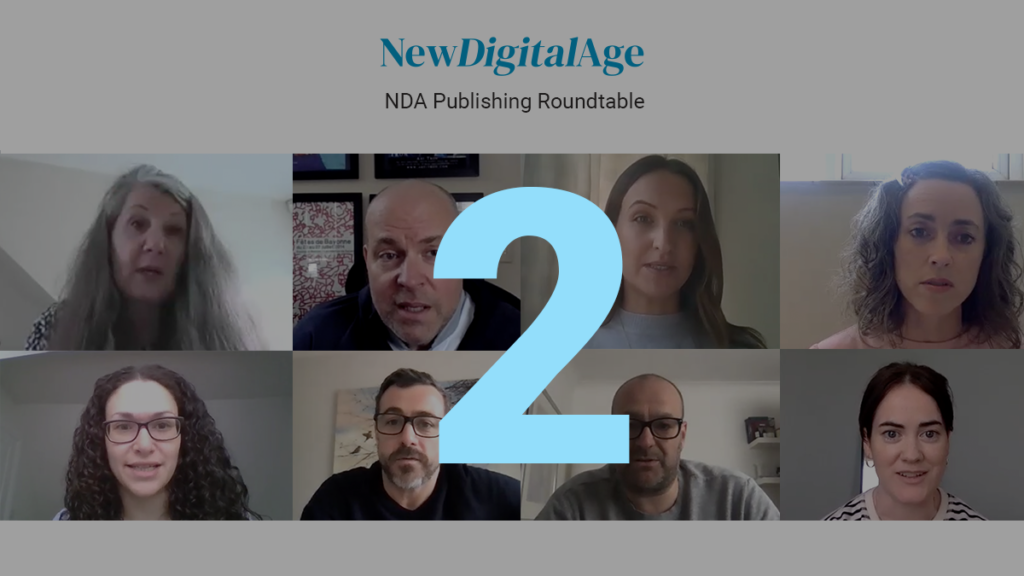Publishers big and small will benefit from a more trusted and transparent digital ecosystem once third party cookies are all but eradicated, say experts from across the industry.
They believe that publishing has suffered from previous digital practices but titles are now in control of their own futures, exploring options such as leveraging their first party data and branching out into new commercial opportunities.
The this was the view at a roundtable, hosted by New Digital Age Editor Justin Pearse, featuring: Alex Kirby, Global Head of Programmatic and Commercial Data, Dennis; Jemima Villaneuva, Executive Director, EMEA, The Atlantic; Charlotte Taylor, Head of Publishing & Audior Spark Foundry; Jane Brady, Head of Brand Partnerships, Mumsnet; Tim Cronin, VP Sales, AAX; Steve Filler, UK Country Manager, ShowHeroes Group; Tanya Field, Co-founder and CPO, Novatiq; and Dom Perkins, Digital Advertising Strategy Director, Immediate Media.
It’s a journey that Dennis Publishing is already several years along. Alex Kirby, Dennis’ Global Head of Programmatic and Commercial Data, says that this is a huge focus for the group right now. Around five years ago they started working with a DMP with a view to understanding its audiences better and working towards creating that fabled single customer view.
However, “only now is really the first time we’ve had the real drive and opportunity to do it” not only across the commercial piece but also its growing subscription business. Part of the equation is also onboarding a CDP to amplify the work already done.
She talks through how publishers such as hers are having to test and learn from both deterministic (from first-party data) and probabilistic (using a wide range of multiple channels) IDs technology to find the best way forward. “We’re getting good early results at the moment.”
Kirby adds that advertisers increasingly want access to their audiences, but questions how best could publishers deliver that “at scale, in an easy way, to replace the ease of what happened in the past”.
Both Mumsnet’s Head of Brand Partnerships Jane Brady and The Atlantic’s EMEA Executive Director Jemima Villaneuva are positive about the opportunities that their own data can bring to commercial partners.
Brady believes that it has helped change the way it is conversing with advertisers and says: “It’s actually given us an opportunity to re-evaluate the whole concept of identity.”
She continues: “The value of our first party data starts to be realised when you talk to partners and they are aware of what will be changing in the next year. It’s about putting a plan in place now and working towards that, although of course none of us knows what the winning formula will be.”
Key of advertiser concern regarding Mumsnet has been around moderation because of its user-led content creation, she says, adding: “We understand brands concerns and we have a strong moderation policy in place. However that said, I think it’s time for brands to look at it a little differently, take a few more risks, and encourage genuine conversation which is much more authentic and valuable for them. By doing so they may start to tap into the power of UGC and get some real results that could help them navigate the future of building their first party data.””
For Villaneuva crunching the data has led The Atlantic to the creation of valuable new editorial (and associated commercial) assets. “When we looked into our data we found that the content areas, C-Suites for instance, were most deeply engaged with and found that family content always came up within the top five,” she says.
“We saw early on the editorial opportunity. It was repeatedly gaining almost 40% more engagement than the average editorial – and so that led us to create an entirely new vertical.”
Morgan Stanley was its launch sponsor of the family section, which Villaneuva says initially might seem an odd association but “actually it was a perfect platform for them to showcase their whole suite of products all the way from savings and mortgages through to retirement and pensions”.
About time, too, says Immediate Media’s Dom Perkins. He says publishers have for too long sat back and let the large platforms and other digital players dominate proceedings, but that the road back relies on content – backed by first party data.
“The quality editorial we put out generates great data but we never really stood up and thought, what are we going to do with it?” he says.
Tanya Field, Co-founder and CPO of Novatiq, is excited by the concept of publishers taking back control having effectively ceded the value of their data in the ecosystem of (yester)day. “Following the demise of the infrastructure that allowed other people to sweep in and place layers over the top, publishers have the chance to emerge as a strength in the industry with first-party data. They can use that data not just to reach audiences but very importantly for measurement and attribution.”
Perkins concurs. “[As an advertiser] I’d want to buy in the most simplest form where I can actually understand the measurement and attribution that I’m delivering across – I don’t want it to be a blind buy.”
As soon as buyers could better access premium audiences at scale and better measure and attribute that back then money would flow back into premium environments from hyper-targeted ‘blind’ environments, he adds.
He says that the adage that ‘nobody ever gets fired for IBM’ is the same today as buying Facebook or Google. “We don’t make it easy for people to buy across publishers.”
And it seems that advertisers are in agreement.
Says Charlotte Taylor, Head of Publishing & Audio of Spark Foundry, “We do have a huge appetite. Obviously we want to know that the data is there and we do want to work with these publishers at scale.”
She points to “ brilliant collaboration across the market” with the likes of the shared publisher ad network The Ozone project coming to fruition.
An age-old challenge to scale was brand safety. “There is still a simple concern of brands just not wanting to appear alongside content they might perceive as being damaging for their brand, so by the time we go through brand safety regulations sometimes it is just very difficult for us to scale. And that’s really frustrating because the publishing market is doing lots to combat this.”
AI-powered tools are being introduced to analyse words and context in order to deliver true brand safety ratings but sometimes publishers still aren’t getting a seat at the table among the bigger players because of those deep-seated concerns, she adds.
For Steve Filler, UK Country Manager, ShowHeroes Group, there is an opportunity to benefit and boost scale and context in a post-cookie world, be that by alternative ID solutions or otherwise or a combination.
He says of the situation today: “What we see is agencies set out with really good intentions to work with certain publishers and apply data. But as it gets tougher and tougher they end up defaulting to the easy access of the big platforms.”
However, he believes that post-cookie identity solutions could help “align buyers’ expectations and knowledge with the audiences they’re able to reach”. “Hopefully publishers will be in a much stronger place.”
Only, says Perkins, if publishers’ can hold the consumer trust. “Everything we’re doing, and I presume most publishers are, is putting the user first, protecting their privacy, understanding what they want and understanding what we can do with that. Remember, there is a finite amount of people in this country that we could target.”
Tim Cronin, AAX VP Sales, agrees, citing the rise of adblocking as an example of the precarious nature of the industry.
“We work with the leading adblockers,” he says. “For publishers that means that consumers are always going to maintain a level of control,” he says. “If the industry can’t regulate itself then the consumer may step in and get involved.”
They want – and are increasingly demanding – transparent solutions with a value-add in return for their privacy.
“Advertisers and brands, ask publishers for what they want, which is highly targeted, and so that supply demand imbalance is impacted. Publishers can end up selling 1000s of targeted impressions at high CPMs while millions go unsold. So the market gets flooded with ads that are bigger, more intrusive, and that’s led to adblocking.”
He concludes: “I think a lot of everything is to do with maintaining the premium aspect, maintaining some level of premium or scarcity. It’s been a big challenge, because brands ask for everything.
“It has been hard for publishers to say no.”
The first article in this series can be read here.









